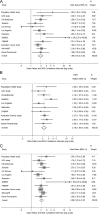Cigarette smoking and adenocarcinomas of the esophagus and esophagogastric junction: a pooled analysis from the international BEACON consortium
- PMID: 20716718
- PMCID: PMC2935475
- DOI: 10.1093/jnci/djq289
Cigarette smoking and adenocarcinomas of the esophagus and esophagogastric junction: a pooled analysis from the international BEACON consortium
Abstract
Background: Previous studies that showed an association between smoking and adenocarcinomas of the esophagus and esophagogastric junction were limited in their ability to assess differences by tumor site, sex, dose-response, and duration of cigarette smoking cessation.
Methods: We used primary data from 10 population-based case-control studies and two cohort studies from the Barrett's Esophagus and Esophageal Adenocarcinoma Consortium. Analyses were restricted to white non-Hispanic men and women. Patients were classified as having esophageal adenocarcinoma (n = 1540), esophagogastric junctional adenocarcinoma (n = 1450), or a combination of both (all adenocarcinoma; n = 2990). Control subjects (n = 9453) were population based. Associations between pack-years of cigarette smoking and risks of adenocarcinomas were assessed, as well as their potential modification by sex and duration of smoking cessation. Study-specific odds ratios (ORs) estimated using multivariable logistic regression models, adjusted for age, sex, body mass index, education, and gastroesophageal reflux, were pooled using a meta-analytic methodology to generate summary odds ratios. All statistical tests were two-sided.
Results: The summary odds ratios demonstrated strong associations between cigarette smoking and esophageal adenocarcinoma (OR = 1.96, 95% confidence interval [CI] = 1.64 to 2.34), esophagogastric junctional adenocarcinoma (OR = 2.18, 95% CI = 1.84 to 2.58), and all adenocarcinoma (OR = 2.08, 95% CI = 1.83 to 2.37). In addition, there was a strong dose-response association between pack-years of cigarette smoking and each outcome (P < .001). Compared with current smokers, longer smoking cessation was associated with a decreased risk of all adenocarcinoma after adjusting for pack-years (<10 years of smoking cessation: OR = 0.82, 95% CI = 0.60 to 1.13; and > or =10 years of smoking cessation: OR = 0.71, 95% CI = 0.56 to 0.89). Sex-specific summary odds ratios were similar.
Conclusions: Cigarette smoking is associated with increased risks of adenocarcinomas of the esophagus and esophagogastric junction in white men and women; compared with current smoking, smoking cessation was associated with reduced risks.
Figures

References
-
- Botterweck AA, Schouten LJ, Volovics A, Dorant E, van Den Brandt PA. Trends in incidence of adenocarcinoma of the oesophagus and gastric cardia in ten European countries. Int J Epidemiol. 2000;29(4):645–654. - PubMed
-
- Vizcaino AP, Moreno V, Lambert R, Parkin DM. Time trends incidence of both major histologic types of esophageal carcinomas in selected countries, 1973–1995. Int J Cancer. 2002;99(6):860–868. - PubMed
-
- Bosetti C, Levi F, Ferlay J, et al. Trends in oesophageal cancer incidence and mortality in Europe. Int J Cancer. 2008;122(5):1118–1129. - PubMed
Publication types
MeSH terms
Grants and funding
- U01-CA57983/CA/NCI NIH HHS/United States
- CA59636/CA/NCI NIH HHS/United States
- R01 CA57947-03/CA/NCI NIH HHS/United States
- ZIA CP010136/ImNIH/Intramural NIH HHS/United States
- CSO_/Chief Scientist Office/United Kingdom
- R21DKO77742/PHS HHS/United States
- U01-CA57923/CA/NCI NIH HHS/United States
- R01 DK063616/DK/NIDDK NIH HHS/United States
- P30 ES010126/ES/NIEHS NIH HHS/United States
- K05 CA124911/CA/NCI NIH HHS/United States
- R01-CA30022/CA/NCI NIH HHS/United States
- U01 CA057949/CA/NCI NIH HHS/United States
- MRC_/Medical Research Council/United Kingdom
- R37-CA41530/CA/NCI NIH HHS/United States
LinkOut - more resources
Full Text Sources
Medical

